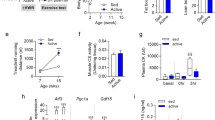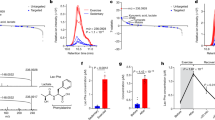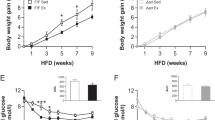Abstract
Exercise improves health and well-being across diverse organ systems, and elucidating mechanisms underlying the beneficial effects of exercise can lead to new therapies. Here, we show that transforming growth factor-β2 (TGF-β2) is secreted from adipose tissue in response to exercise and improves glucose tolerance in mice. We identify TGF-β2 as an exercise-induced adipokine in a gene expression analysis of human subcutaneous adipose tissue biopsies after exercise training. In mice, exercise training increases TGF-β2 in subcutaneous white adipose tissue (scWAT) and serum, and its secretion from fat explants. Transplanting scWAT from exercise-trained wild-type mice, but not from adipose-tissue-specific Tgfb2−/− mice, into sedentary mice improves glucose tolerance. TGF-β2 treatment reverses the detrimental metabolic effects of high-fat feeding in mice. Lactate, a metabolite released from muscle during exercise, stimulates TGF-β2 expression in human adipocytes. Administration of the lactate-lowering agent dichloroacetate during exercise training in mice decreases circulating TGF-β2 levels and reduces exercise-stimulated improvements in glucose tolerance. Thus, exercise training improves systemic metabolism through inter-organ communication with fat via a lactate–TGF-β2 signaling cycle.
This is a preview of subscription content, access via your institution
Access options
Access Nature and 54 other Nature Portfolio journals
Get Nature+, our best-value online-access subscription
$29.99 / 30 days
cancel any time
Subscribe to this journal
Receive 12 digital issues and online access to articles
$119.00 per year
only $9.92 per issue
Buy this article
- Purchase on Springer Link
- Instant access to full article PDF
Prices may be subject to local taxes which are calculated during checkout






Similar content being viewed by others
Data availability
All data underlying the findings reported in this manuscript are provided as part of the article. Source data are available online. Mouse and human microarray data are available in the Gene Expression Omnibus database under accession numbers GSE68161 and GSE116801. The raw data that are not already presented in the figures are available from the corresponding author upon reasonable request.
References
Stanford, K. I. & Goodyear, L. J. Exercise and type 2 diabetes: molecular mechanisms regulating glucose uptake in skeletal muscle. Adv. Physiol. Educ. 38, 308–314 (2014).
Fiuza-Luces, C., Garatachea, N., Berger, N. A. & Lucia, A. Exercise is the real polypill. Physiology 28, 330–358 (2013).
Booth, F. W., Roberts, C. K. & Laye, M. J. Lack of exercise is a major cause of chronic diseases. Compr. Physiol. 2, 1143–1211 (2012).
Colberg, S. R. et al. Exercise and Type 2 Diabetes: The American College of Sports Medicine and the American Diabetes Association: joint position statement executive summary. Diabetes Care 33, e147–67 (2010).
Gollisch, K. S. C. et al. Effects of exercise training on subcutaneous and visceral adipose tissue in normal- and high-fat diet-fed rats. Am. J. Physiol. Endocrinol. Metab. 297, 495–504 (2009).
Stanford, K. I. & Goodyear, L. J. Muscle–adipose tissue cross talk. Cold Spring Harb. Perspect. Med. 4, a029801 (2017).
Craig, B. W., Hammons, G. T., Garthwaite, S. M., Jarett, L. & Holloszy, J. O. Adaptation of fat cells to exercise: response of glucose uptake and oxidation to insulin. J. Appl. Physiol. 51, 1500–1506 (1981).
You, T., Arsenis, N. C., Disanzo, B. L. & Lamonte, M. J. Effects of exercise training on chronic inflammation in obesity: current evidence and potential mechanisms. Sports Med. 43, 243–256 (2013).
Porter, J. W. et al. Anti-inflammatory effects of exercise training in adipose tissue do not require FGF21. J. Endocrinol. 235, 97–109 (2017).
Kawanishi, N., Yano, H., Yokogawa, Y. & Suzuki, K. Exercise training inhibits inflammation in adipose tissue via both suppression of macrophage infiltration and acceleration of phenotypic switching from M1 to M2 macrophages in high-fat-diet-induced obese mice. Exerc. Immunol. Rev. 16, 105–118 (2010).
Rao, R. R. et al. Meteorin-like is a hormone that regulates immune–adipose interactions to increase beige fat thermogenesis. Cell 157, 1279–1291 (2014).
Bostrom, P. et al. A PGC1 alpha dependent myokine that drives brown fat like development of white fat and thermogenesis. Nature 481, 463–468 (2012).
Kajimura, S., Spiegelman, B. M. & Seale, P. Brown and beige fat: physiological roles beyond heat generation. Cell Metab. 22, 546–559 (2015).
Stallknecht, B., Vinten, J., Ploug, T. & Galbo, H. Increased activities of mitochondrial enzymes in white adipose tissue in trained rats. Am. J. Physiol. 261, E410–E414 (1991).
Trevellin, E. et al. Exercise training induces mitochondrial biogenesis and glucose uptake in subcutaneous adipose tissue through eNOS-dependent mechanisms. Diabetes 63, 2800–2811 (2014).
Stanford, K. I. et al. A novel role for subcutaneous adipose tissue in exercise-induced improvements in glucose homeostasis. Diabetes 64, 2002–2014 (2015).
Massague, J. TGF-β signal transduction. Annu. Rev. Biochem. 67, 753–791 (1998).
LEASK, A. TGF-β signaling and the fibrotic response. FASEB J. 18, 816–827 (2004).
Li, M. O., Wan, Y. Y. & Flavell, R. A. T. Cell-produced transforming growth factor-β1 controls T cell tolerance and regulates Th1- and Th17-cell differentiation. Immunity 26, 579–591 (2007).
Sanford, L. P. et al. TGFβ2 knockout mice have multiple developmental defects that are non-overlapping with other TGFβ knockout phenotypes. Development 124, 2659–2670 (1997).
Doetschman, T. et al. Generation of mice with a conditional allele for the transforming growth factor β3 gene. Genesis 50, 59–66 (2012).
Ishtiaq Ahmed, A. S., Bose, G. C., Huang, L. & Azhar, M. Generation of mice carrying a knockout-first and conditional-ready allele of transforming growth factor β2 gene. Genesis 52, 817–826 (2014).
Azhar, M. et al. Generation of mice with a conditional allele for transforming growth factor β1 gene. Genesis 47, 423–431 (2009).
de Martin, R. et al. Complementary DNA for human glioblastoma-derived T cell suppressor factor, a novel member of the transforming growth factor-β gene family. EMBO J. 6, 3673–3677 (1987).
Zhang, H., Yang, P., Zhou, H., Meng, Q. & Huang, X. Involvement of Foxp3-expressing CD4+ CD25+ regulatory T cells in the development of tolerance induced by transforming growth factor-β2-treated antigen-presenting cells. Immunology 124, 304–314 (2008).
Maheshwari, A. et al. TGF-β2 suppresses macrophage cytokine production and mucosal inflammatory responses in the developing intestine. Gastroenterology 140, 242–253 (2011).
Shimizu, C. et al. Transforming growth factor-β signaling pathway in patients with Kawasaki disease. Circ. Cardiovasc. Genet. 4, 16–25 (2011).
Yfanti, C. et al. Effect of antioxidant supplementation on insulin sensitivity in response to endurance exercise training. Am. J. Physiol. Endocrinol. Metab. 300, E761–E770 (2011).
Yfanti, C. et al. Antioxidant supplementation does not alter endurance training adaptation. Med. Sci. Sports Exerc. 42, 1388–1395 (2010).
Camon, E. The Gene Ontology Annotation (GOA) Database: sharing knowledge in Uniprot with Gene Ontology. Nucleic Acids Res. 32, 262D–266D (2004).
Motiani, P. et al. Decreased insulin-stimulated brown adipose tissue glucose uptake after short-term exercise training in healthy middle aged men. Diabetes Obes. Metab. 19, 1379–1388 (2017).
Schulz, T. J. et al. Brown-fat paucity due to impaired BMP signalling induces compensatory browning of white fat. Nature 495, 379–383 (2013).
Rasbach, Ka et al. PGC-1α regulates a HIF2α-dependent switch in skeletal muscle fiber types. Proc. Natl Acad. Sci. USA 107, 21866–21871 (2010).
Wu, Z. et al. Mechanisms controlling mitochondrial biogenesis and respiration through the thermogenic coactivator PGC-1. Cell 98, 115–124 (1999).
Cohen, P. et al. Ablation of PRDM16 and beige adipose causes metabolic dysfunction and a subcutaneous to visceral fat switch. Cell 156, 304–316 (2014).
Tsunoda, T. & Takagi, T. Estimating transcription factor bindability on DNA. Bioinformatics 15, 622–630 (1999).
Benatti, F. B. & Pedersen, B. K. Exercise as an anti-inflammatory therapy for rheumatic diseases–myokine regulation. Nat. Rev. Rheumatol. 11, 86–97 (2014).
Stacpoole, P. W., Nagaraja, N. V. & Hutson, A. D. Efficacy of dichloroacetate as a lactate-lowering drug. J. Clin. Pharmacol. 43, 683–691 (2003).
Goodwin, M. L., Harris, J. E., Hernández, A. & Gladden, L. B. Blood lactate measurements and analysis during exercise: a guide for clinicians. J. Diabetes Sci. Technol. 1, 558–569 (2007).
Hashimoto, T., Hussien, R., Oommen, S., Gohil, K. & Brooks, G. Lactate sensitive transcription factor network in L6 cells: activation of MCT1 and mitochondrial biogenesis. FASEB J. 21, 2602–2612 (2007).
Carrière, A. et al. Browning of white adipose cells by intermediate metabolites: an adaptive mechanism to alleviate redox pressure. Diabetes 63, 3253–3265 (2014).
Gulick, T., Cresci, S., Caira, T., Moore, D. D. & Kelly, D. P. The peroxisome proliferator-activated receptor regulates mitochondrial fatty acid oxidative enzyme gene expression. Proc. Natl Acad. Sci. USA 91, 11012–11016 (1994).
Ahmadian, M. et al. PPARγ signaling and metabolism: the good, the bad and the future. Nat. Med. 99, 557–566 (2013).
Li, P., Zhu, Z., Lu, Y. & Granneman, J. G. Metabolic and cellular plasticity in white adipose tissue II: role of peroxisome proliferator-activated receptor-α. Am. J. Physiol. Endocrinol. Metab. 289, E617–E626 (2005).
Schenk, S., Saberi, M. & Olefsky, J. M. Insulin sensitivity: modulation by nutrients and inflammation. J. Clin. Investig. 118, 2992–3002 (2008).
Greenberg, A. S. & Obin, M. S. Obesity and the role of adipose tissue in inflammation and metabolism. Am. J. Clin. Nutr. 83, 461–465 (2006).
Xu, H. et al. Chronic inflammation in fat plays a crucial role in the development of obesity-related insulin resistance. J. Clin. Invest. 112, 1821–1830 (2003).
Gleeson, M. et al. The anti-inflammatory effects of exercise: mechanisms and implications for the prevention and treatment of disease. Nat. Rev. Immunol. 11, 607–315 (2011).
Bradley, R. L., Jeon, J. Y., Liu, F. & Maratos-Flier, E. Voluntary exercise improves insulin sensitivity and adipose tissue inflammation in diet-induced obese mice. Am. J. Physiol. Endocrinol. Metab. 295, E586–E594 (2008).
de Martin, R. et al. Complementary DNA for human glioblastoma-derived T cell suppressor factor, a novel member of the transforming growth factor-β gene family. EMBO J. 6, 3673–3677 (1987).
Xue, R. et al. Clonal analyses and gene profiling identify genetic biomarkers of the thermogenic potential of human brown and white preadipocytes. Nat. Med. 21, 760–768 (2015).
Shamsi, F. & Tseng, Y. H. Protocols for generation of immortalized human brown and white preadipocyte cell lines. Methods Mol. Biol. 1566, 77–85 (2017).
Hoque, R., Farooq, A., Ghani, A., Gorelick, F. & Mehal, W. Z. Lactate reduces liver and pancreatic injury in toll-like receptor- and inflammasome-mediated inflammation via gpr81-mediated suppression of innate immunity. Gastroenterology 146, 1763–1774 (2014).
Ferré, P., Leturque, A., Burnol, A. F., Penicaud, L. & Girard, J .A. A method to quantify glucose utilization in vivo in skeletal muscle and white adipose tissue of the anaesthetized rat. Biochem. J. 228, 103–110 (1985).
Kramer, H. F. et al. AS160 regulates insulin- and contraction-stimulated glucose uptake in mouse skeletal muscle. J. Biol. Chem. 281, 31478–31485 (2006).
Ho, R. C., Alcazar, O., Fujii, N., Hirshman, M. F. & Goodyear, L. J. p38γ MAPK regulation of glucose transporter expression and glucose uptake in L6 myotubes and mouse skeletal muscle. Am. J. Physiol. Regul. Integr. Comp. Physiol. 286, R342–R349 (2004).
Lynes, M. D. et al. The cold-induced lipokine 12,13-diHOME promotes fatty acid transport into brown adipose tissue. Nat. Med. 23, 631–637 (2017).
Townsend, K. L. et al. Increased mitochondrial activity in BMP7-treated brown adipocytes, due to increased CPT1- and CD36-mediated fatty acid uptake. Antioxid. Redox Signal. 19, 243–257 (2013).
De Keijzer, M. H., Brandts, R. W. & Brans, P. G. W. Evaluation of a biosensor for the measurement of lactate in whole blood. Clin. Biochem. 32, 109–112 (1999).
Li, C. Automating dChip: toward reproducible sharing of microarray data analysis. BMC Bioinformatics 9, 231 (2008).
Ritchie, M. E. et al. Limma powers differential expression analyses for RNA-sequencing and microarray studies. Nucleic Acids Res. 43, e47 (2015).
Subramanian, A. et al. Gene set enrichment analysis: a knowledge-based approach for interpreting genome-wide expression profiles. Proc. Natl Acad. Sci. USA 102, 15545–15550 (2005).
Tian, L. et al. Discovering statistically significant pathways in expression profiling studies. Proc. Natl Acad. Sci. USA 102, 13544–13549 (2005).
Gentleman, R. et al. Bioconductor: open software development for computational biology and bioinformatics. Genome Biol. 5, R80 (2004).
Acknowledgements
This work was supported by NIH grants R01DK099511 and R01DK112283 (to L.J.G.), K23DK114550 (to R.J.W.M.) and the Joslin Diabetes Center DRC (P30 DK36836). H.T. was supported by individual research fellowships from the Uehara Memorial Foundation and Sumitomo Life Welfare Foundation. Y.-H.T. was supported by NIH grant grants R01DK077097 and R01DK102898. K.I.S. was supported by R01-HL138738. M.D.L. was supported by NIH grants T32DK007260, F32DK102320 and K01DK111714. M.A. was supported by NIH grants R01HL126705 and R01HL145064, and American Heart Association Grant-in-Aid grant 17GRNT33650018. B.K.P. and the Centre for Physical Activity Research were supported by a grant from TrygFonden. We thank K. Longval and A. Clermont from the Joslin Diabetes Center Animal Physiology Core, and L. Kannan from Joslin Special Assay Core. We thank L. Rowland, S. Lessard and A. Queiroz for helpful scientific discussions, and N. Prince and C. Doherty for technical support.
Author information
Authors and Affiliations
Contributions
H.T. and C.R.R.A. designed research, carried out experiments, analysed data and wrote the paper. K.I.S. performed experiments with trained mice. R.J.W.M. performed and analysed human data. P. Nigro carried out all experiments of adipocyte incubation. R.E.R. carried out experiments and analysed data with Tgfb2-knockout mice and TGF-β2-treated mice. R.X. designed and performed Seahorse assays and provided human white preadipocytes. M.S. carried out experiments and analysed data of cell sorting. M.D.L. carried out in vivo imaging studies for fatty acid uptake. K.S. and J.D.M. performed genotyping of Tgfb2-knockout mice and cell experiments. J.M.D. carried out correlation analysis of microarray data and analysed bioinformatic data. M.-Y.L. carried out gene expression analysis of human adipose tissue. E.B. carried out fatty acid uptake in vitro and Seahorse assays. H.P. and J.M.D. performed bioinformatics analysis. M.F.H. performed in vivo experiments and supervised all experiments. M.A. established and provided Tgfb2-knockout mice. J.C.H., P. Nuutila, K.K.K., B.K.P. and S.N. carried out and provided human samples. C.R.K. supervised in vivo and in vitro experiments with adipocytes or adipose tissue. Y.-H.T. supervised experiments with human preadipocytes and provided immortalized brown preadipocytes. L.J.G. directed the research project, designed experiments and wrote the paper. All authors participated in the manuscript review. All authors approved the final manuscript.
Corresponding author
Ethics declarations
Competing interests
The authors declare no competing interests.
Additional information
Publisher’s note: Springer Nature remains neutral with regard to jurisdictional claims in published maps and institutional affiliations.
Supplementary information
Supplementary Information
Supplementary Figures 1–14 and Supplementary Tables 2 and 3
Supplementary Table 1
Human scWAT gene expression data (human_gene_stats_unweighted)
Rights and permissions
About this article
Cite this article
Takahashi, H., Alves, C.R.R., Stanford, K.I. et al. TGF-β2 is an exercise-induced adipokine that regulates glucose and fatty acid metabolism. Nat Metab 1, 291–303 (2019). https://doi.org/10.1038/s42255-018-0030-7
Published:
Issue Date:
DOI: https://doi.org/10.1038/s42255-018-0030-7
This article is cited by
-
A two-way street – cellular metabolism and myofibroblast contraction
npj Regenerative Medicine (2024)
-
Lactate coordinated with exercise promoted the browning of inguinal white adipose tissue
Journal of Physiology and Biochemistry (2024)
-
High-intensity interval training induces lactylation of fatty acid synthase to inhibit lipid synthesis
BMC Biology (2023)
-
Exercise metabolism and adaptation in skeletal muscle
Nature Reviews Molecular Cell Biology (2023)
-
Effects of acute aerobic exercise on cytokines, klotho, irisin, and vascular endothelial growth factor responses in rheumatoid arthritis patients
Irish Journal of Medical Science (1971 -) (2023)



